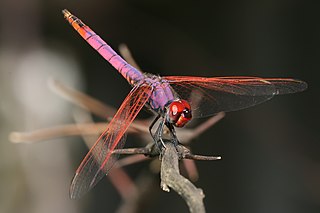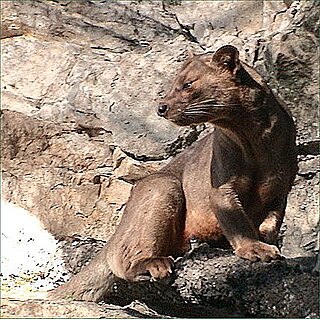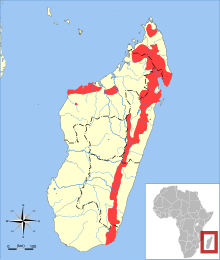
The Eastern falanouc is a rare mongoose-like mammal in the carnivoran family Eupleridae endemic to Madagascar.

The Malagasy mouse-eared bat is a species of bat in the family Vespertilionidae that is endemic to Madagascar.

Astacoides is a genus of freshwater crayfish endemic to Madagascar. The first specimens were brought to Europe in 1839, and seven species are now recognised, most of which are considered as threatened on the IUCN Red List. They are large and slow-growing, and are threatened by habitat loss, overexploitation by local people and by spread of introduced non-indigenous marbled crayfish. They are only found in a relatively small part of the island, mostly in undisturbed upland areas. They belong to the Gondwana-distributed family Parastacidae, but their nearest relatives live in Australasia, there being no native crayfish in mainland Africa or India.

Trithemis is a genus of dragonflies in the family Libellulidae. They are commonly known as dropwings. There are over 40 species, mainly from Africa; two are endemic to Madagascar, and five can be found in Asia. They are found in a wide variety of habitats; some species being adapted to permanent streams in forests, and others being capable of breeding in temporary pools in deserts.

Fallicambarus is a genus of crayfish in the family Cambaridae from the United States and Canada. It includes 12 species, of which one is on the IUCN Red List as a vulnerable species (VU) and one as an endangered species (EN). The species of this genus are all restricted to three states or fewer, from Texas and Oklahoma east to Florida.

Euplerinae, more commonly known as malagasy civets, is a subfamily of carnivorans that includes four species restricted to Madagascar. Together with the subfamily Galidiinae, which also only occurs on Madagascar, it forms the family Eupleridae. Members of this subfamily, which include the fossa, falanoucs and Malagasy civet, were placed in families like Felidae and Viverridae before genetic data indicated their consanguinity with other Madagascar carnivorans. Within the subfamily, the falanouc and Malagasy civet are more closely related to each other than to the fossa.

The World's 25 Most Endangered Primates is a list of highly endangered primate species selected and published by the International Union for Conservation of Nature (IUCN) Species Survival Commission (SSC) Primate Specialist Group (PSG), the International Primatological Society (IPS), Global Wildlife Conservation (GWC), and Bristol Zoological Society (BZS). The IUCN/SSC PSG worked with Conservation International (CI) to start the list in 2000, but in 2002, during the 19th Congress of the International Primatological Society, primatologists reviewed and debated the list, resulting in the 2002–2004 revision and the endorsement of the IPS. The publication was a joint project between the three conservation organizations until the 2012–2014 list when BZS was added as a publisher. The 2018–2020 list was the first time Conservation International was not among the publishers, replaced instead by GWC. The list has been revised every two years following the biannual Congress of the IPS. Starting with the 2004–2006 report, the title changed to "Primates in Peril: The World's 25 Most Endangered Primates". That same year, the list began to provide information about each species, including their conservation status and the threats they face in the wild. The species text is written in collaboration with experts from the field, with 60 people contributing to the 2006–2008 report and 85 people contributing to the 2008–2010 report. The 2004–2006 and 2006–2008 reports were published in the IUCN/SSC PSG journal Primate Conservation,, since then they have been published as independent publications.
The western falanouc is a rare mongoose-like mammal endemic to Madagascar. Until recently, the eastern falanouc was the only recognized species in the genus Eupleres. In 2010, Goodman and Helgen provided morphological evidence showing the two falanoucs are each a separate species and are found in separate geographical locations. E. major is larger and browner compared to E. goudotii and has a diet consisting mainly of invertebrates such as worms, snails, and slugs.








